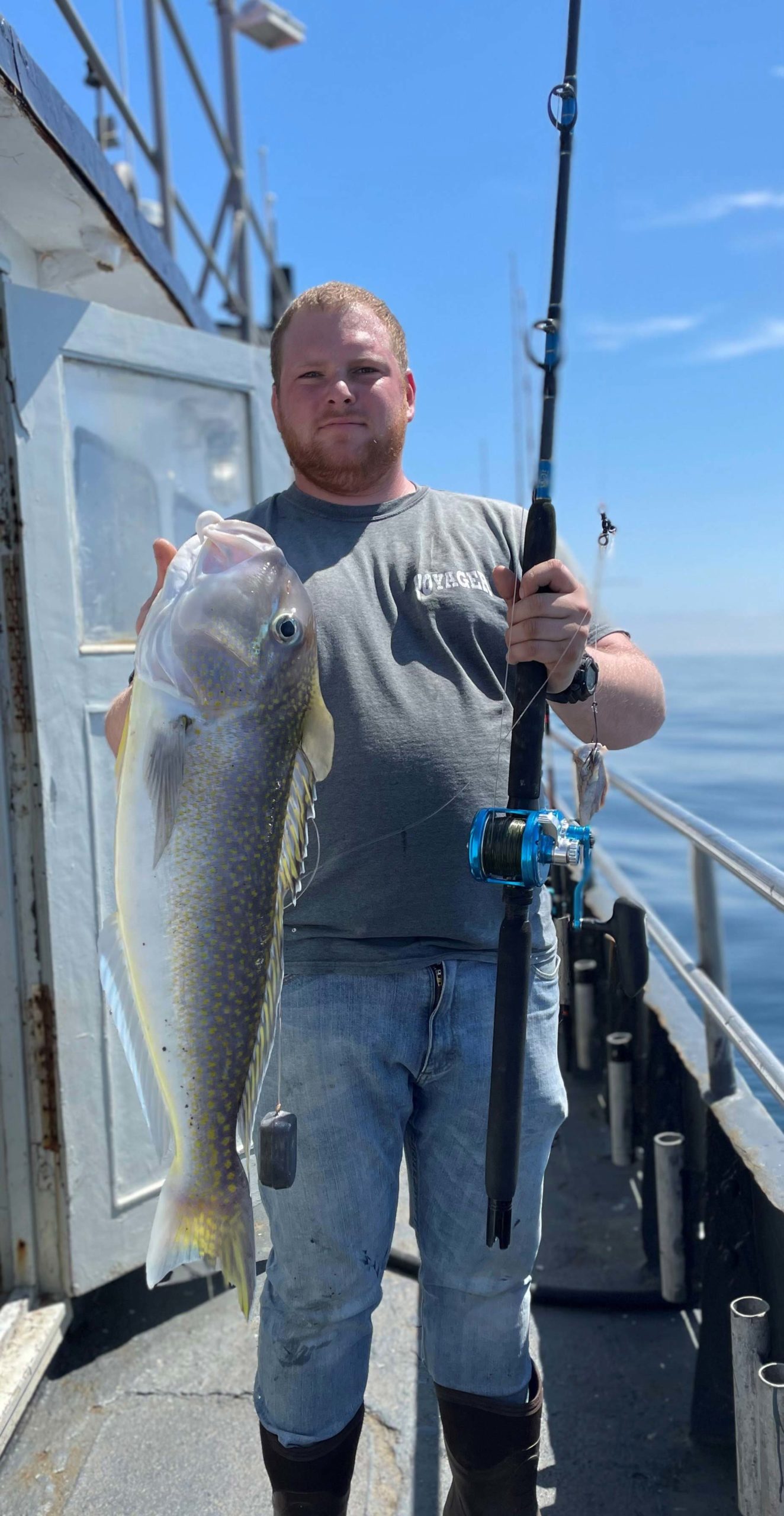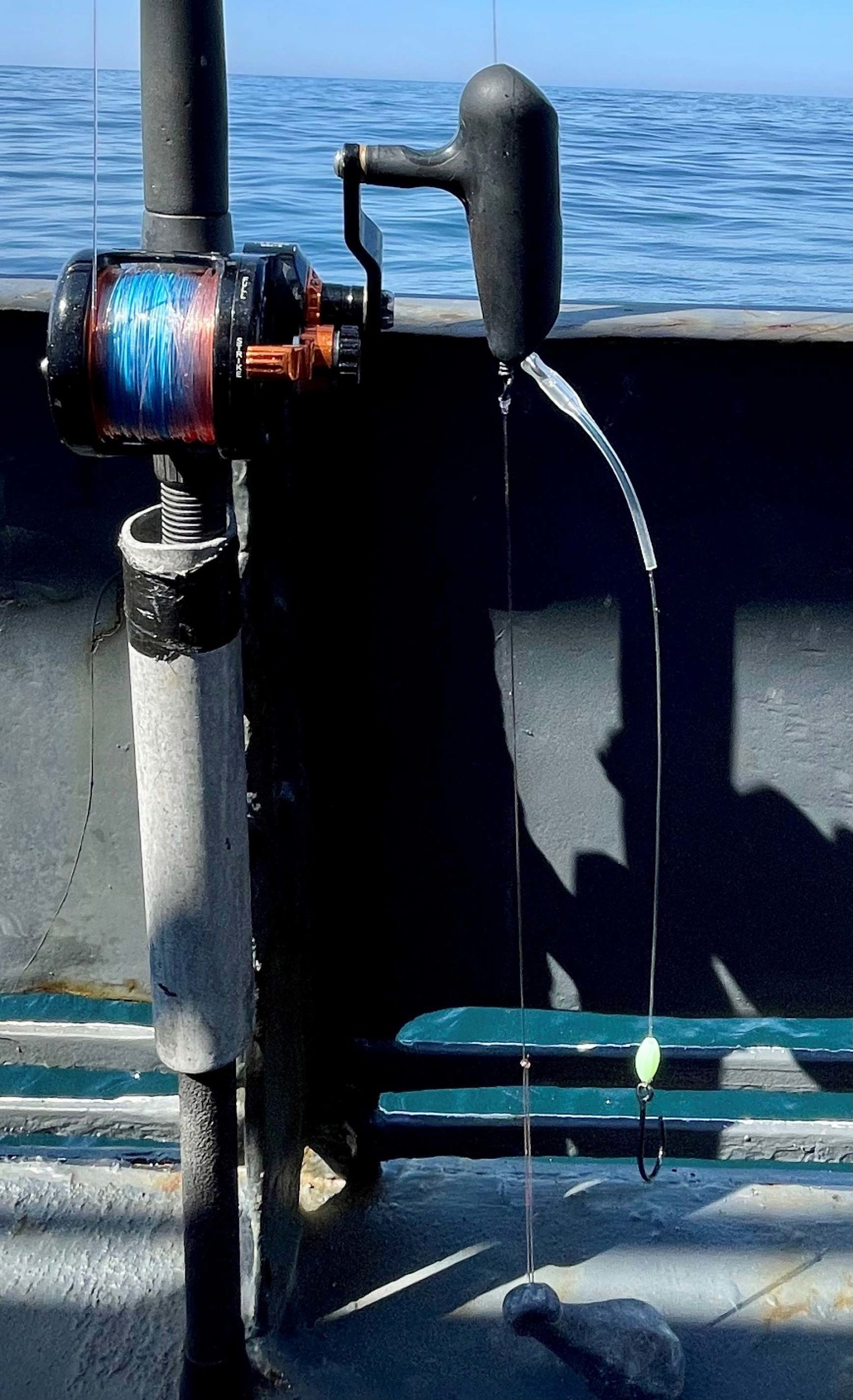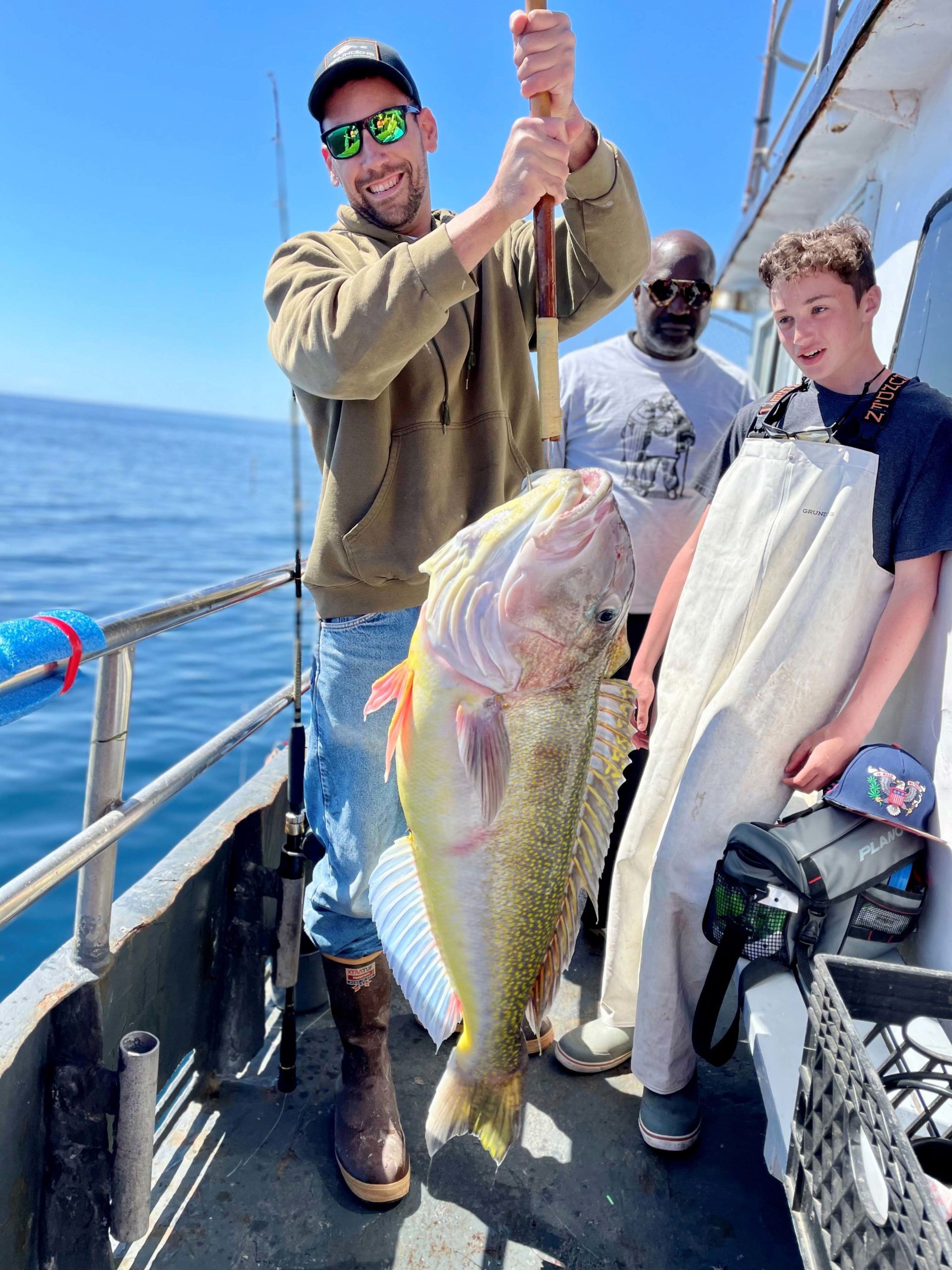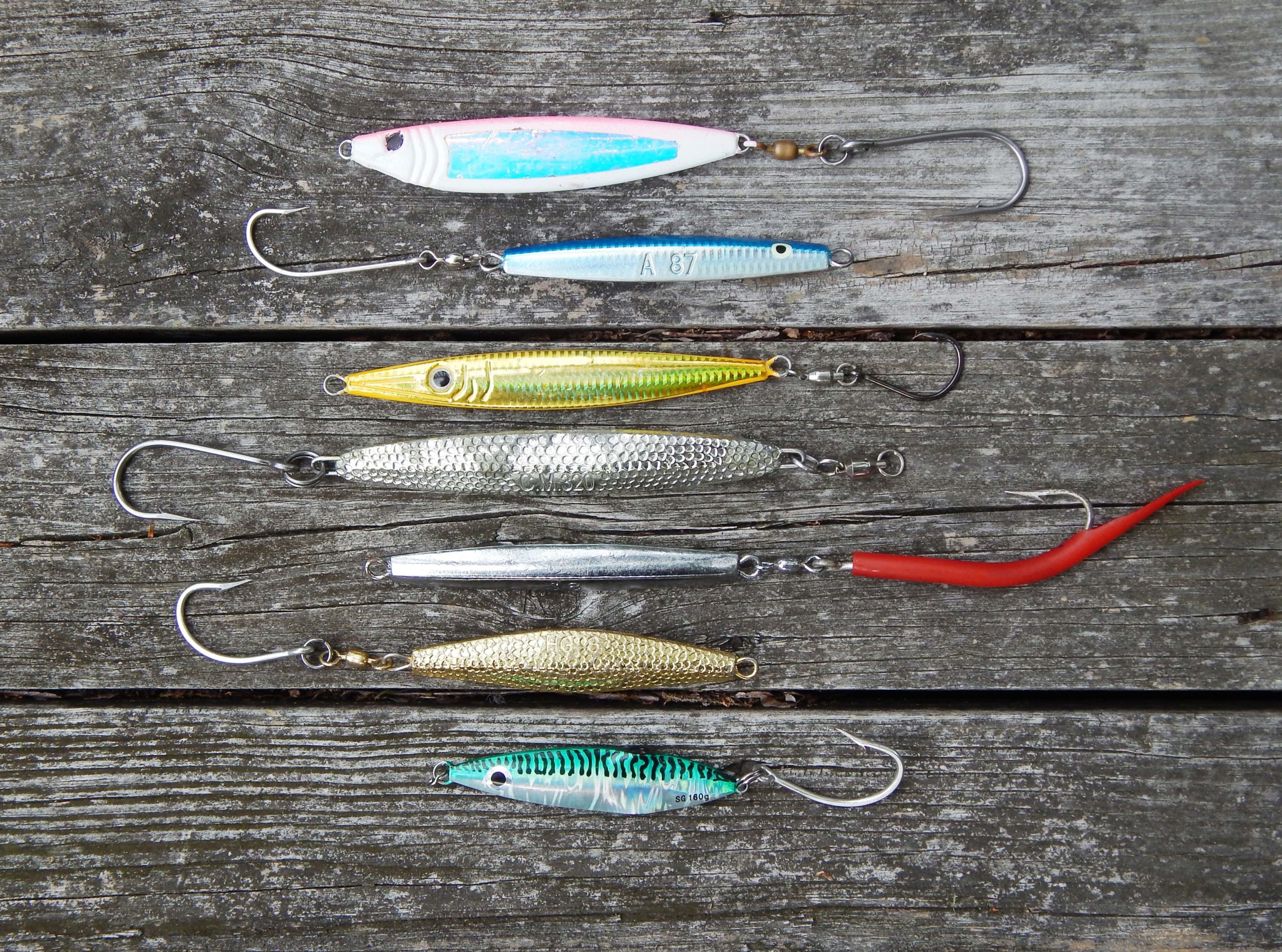Strike gold offshore, try tilefishing on a party boat!
The winter is ending and the weather is starting to turn. You’ve been cooped up bending rods on the ceiling and cleaning out old hooks from your fluke bag. It seems like yesterday you were doing this same routine. You love it (sort of) but we keep coming back for more. An addiction to preparation and organization ensures you’re ready for that moment on the ocean when you’ll pull a trick out of your bag. But what if there’s more to this sport here in Sheepshead Bay? What if there’s more beyond drifting for fluke while passing the Highlands; more than dropping to the sandy bottom for our local scup off the inlet; more than a trophy bass near Lady Liberty. I’m here to tell you that you could use these same techniques as well as everything you’ve learned inshore and apply them in the depths of the abyss and you’ll catch a trophy fish that will leave you speechless at the rail full of adrenaline—it’s tilefishing out of Sheepshead Bay, Brooklyn.
A Little History

It was in the early 1970s when wire line and sash weights were used on heavy tackle to hold bottom. The Tampa owned by Victor Becker was one of the first boats to start sailing for tilefish because of a lack of bluefish in the area—our fishermen were coming back empty handed. He had heard of tilefish being caught in the Hudson Canyon and started advertising weekly trips aboard the Tampa—something new came to Sheepshead Bay. The Tampa, Ranger and Amberjack all started to sail three times a week, old and new customers started to show up. As the years went by bluefish came back to our local grounds and the boats got back to a daily schedule of ocean blues.
Through the last couple of decades, exclusive tilefishing started coming back with a few local head boats in other ports. Some boats would make it a combo trip along with tuna fishing in the fall, but not many would fish exclusively for them and certainly not in Sheepshead Bay, until 2020.
Now that I have your attention, let’s focus on how to get you prepared to join in on this historical fishing and get you at the rail confident that you can bring in one of these beasts. You might be lucky enough to drag that squid and strip right across their nose. Yea that’s right, squid and a strip. Sounds familiar, doesn’t it? That’s because it is—fluke fishing—the all-time beginner’s day out on the water for family and fun. You’ll be at ease to join in on one of these trips. Here are few simple tactics and a tip or two just to get your line wet. In no time you can put your own personality into your tackle, but for now let’s get you on board and catch you a fish. The basic rental rod on board a fluke boat will give you three simple items to catch a fish: sinker, hook, and swivel. Along with a jumbo spearing that you dug out from your bucket and if you’re lucky to have some squid throw a strip on too—it’s that easy. We all know little Johnny who caught that 9-pound doormat his first time out on a rental rod. Yes, it’s that easy and so is the rig.
Easy Rigging
Tilefishing is no different than what you’re used to, except you’re fishing deeper water. Let’s just bump it up a bit as you are targeting fish that could very well be up to 50 pounds and maybe even two at once. Depending on how you like to fish, terminal tackle can be tweaked a bit but above all quality is key. Don’t cheap out, preparation remember? Use 80-pound leader material tied to an 8/0 or 9/0 hook. Both circle and J-hooks work well. Attach an 8- to 12-inch length of leader to your hook and a heavy-duty three-way swivel. Attach another piece of leader material for your sinker to the bottom eye and have your hook approximately 1 to 2 feet above—you made a tilefish rig! What you can add if you choose is a piece of standoff tubing to your swivel and hook leader. If you insist on “jewelry” for your hook, a single glow bead is as far as I would go. You don’t need much but fresh bait to entice these fish.

Now you may be asking how I attach my hook to the leader. Remember, we’re now party boat fishing where tangles are common and we want to relieve them as soon as possible. My personal favorite knots are the Palomar or a doubled up Improved Clinch Knot. I would stay away from crimps and extras. All it ends up doing is costing you money and tangles for yourself and fellow fishermen. If you choose to fish two hooks, it’s fine but keep it at two. No need for three hooks as triple headers are not common and will only result in more drag, tangles and bait depletion for the boat. Personally, I enjoy fishing one hook and I do just fine.
Lastly, you attach a sinker. Simple enough? Yes, but still mistakes can be made. Boats do provide sinkers at a cost but bringing your own bucket of lead can put you at a bit of ease as you don’t have to worry for waiting during a heavy bite. Stay away from anything round and homemade in odd shapes. Brick style sinkers are what you are looking for. These types will sit and stay on the bottom without rolling. Sinkers can range from 14 ounces to 4 pounds depending on the day (hopefully not 4 pounds). Start in the middle and if you think you can work down, go for it. The less weight, the better. It’s open bottom fishing so there is a good chance you won’t lose many pieces of lead.
Deep Sea Rods & Reels
When it comes to rods and reels you can go into several different directions. Without comparing brands, models, and sizes I am going to again keep this basic. Use reels for deep water fishing, where we need a powerful (not fast) retrieve and the right gearing along with line capacity to handle heavy weight and fight a large powerful fish. Big gears, narrow tall spools, and a big comfortable handle. Why tall narrow spools? Because you want the retrieve in a large diameter. It picks up more line opposed to a wide spools which are primarily low in height and will not give you a good turn in diameter for line retrieve.

The Penn 349 Master Mariner with an aluminum spool is a perfect setup for someone looking for an old school reel. Large gearing and plenty of line capacity make this model a good choice. If you are going for a more modern reel, Capt. Paul Paris of the Captain Dave III recommends a Daiwa Ocean Max 10 which has the right gear ratio and plenty of line capacity for all deep-water drops. Don’t feel like going for a record and hand cranking isn’t your thing? The Daiwa Tanacom 750 is the choice for electrics. It’s been tested time and time again and is hands down one of the best electric reels on the current market for this kind of fishing. Spool these reels up with 50- or 60-pound quality braid and a long 50- or 60-pound mono top shot and you are set. Personally, I prefer a longer top shot of maybe 20 to 30 feet or so for a good stretch in the event you hook into a big fish. Ande Pink is a personal choice that has been consistently reliable. An Alberto or Albright Knot will be fine to attach to your braid. I’ve put the Alberto Knot through lots of strain without it failing.
Now that you have your rig, reel, and line all set, let’s get you a good solid rod. Personal preference can go in all directions as long as it’s a rod that can drag a large weight and still have a good bend to play a big fish. A slow tapered rod at least 7 feet 8 inches is what you are looking for. A nice solid foam foregrip to lean on the rail when needed and enough butt to keep under your arm to be comfortable when the time is right helps too I would not overthink this part of the process too much. You can actually go very inexpensive and still be able to fish for these beasts. If you are looking for an “off the rack” rod, Capt. Paul Paris recommends the Daiwa Proteus 8.
Bait & Wait
The time has come to jump aboard and find a good spot to cuddle up in for the journey offshore. When fishing aboard the Capt. Dave III in Sheepshead Bay, a bean bag is your best bet to sit back and begin your journey offshore. Usual sailing times are made along late evenings, so everyone is on a normal sleeping pattern for the ride out.
| JIG EM’ |
| While this article talks about bait fishing for tilefish, keep in mind you can employ a vertical jig tactic for them as well. Use 30-pound braided line with a jig heavy enough to reach the bottom. Tilefish are aggressive so they will have no problem chasing a well presented jig.
|
When arriving to the grounds a bait choice is given, but you are more than welcome to bring your own secret stash. Strips of bluefish, silver eel, salmon belly, mackerel and of course whole squid will all work. Set your bait up so it flutters with ease, just as if you were fluke fishing. Strip first and squid on top. Send it down the ocean floor and just like that, you are drifting for tilefish. Bounce, bounce, bounce; keep that bait moving. These fish are very aggressive and when you get a bite, let them eat. If you swing and miss, go back down. They will come back, just like a fluke. When you hook up, hold on. They are a very hard-fighting fish. No need to rush, remember you are fishing open bottom. Hold that fish up high and fight it accordingly, nice and easy. If you hand crank, they will fight you to the top and be very sporty about it too. If you are using an electric reel and you hook up, remember you are still fighting this fish. Don’t just hit the button and go. Set your drag and if you hook up to a big fish, play the fish as if you were hand cranking. Remember to walk your fish, you need to avoid tangles as best you can.
I hope this leaves you feeling more confident to join in and catch yourself a gold trophy soon. I could go on some more but it’s that time of the day and we have a long steam home. The world of fishing is not so complicated whether you’re a novice or seasoned angler. Keep it simple and always get the basics down first. You’ll be surprised what you can catch with just a plain hook and some bait.



